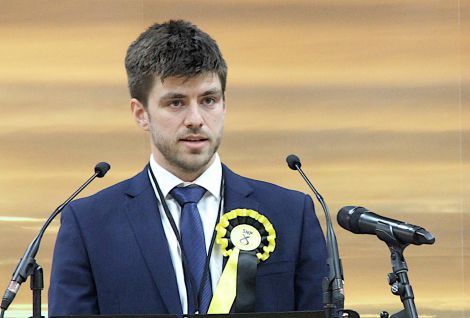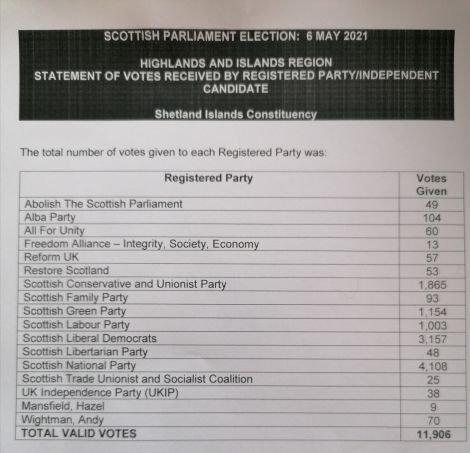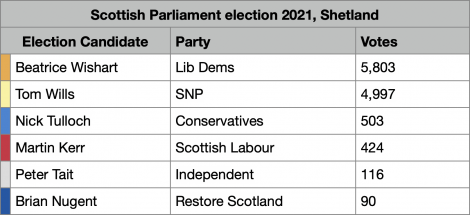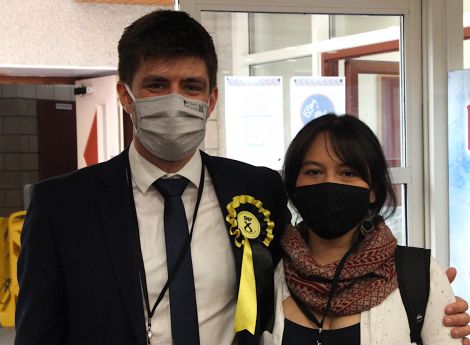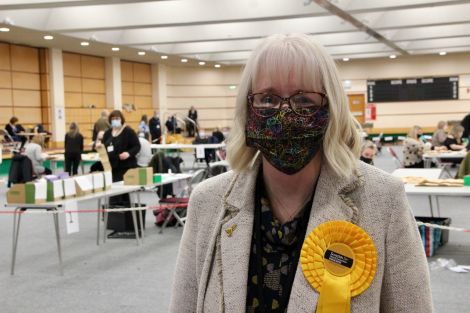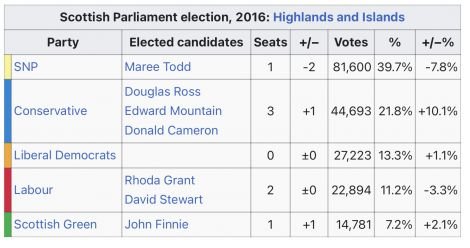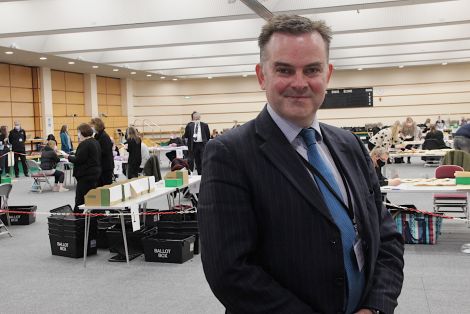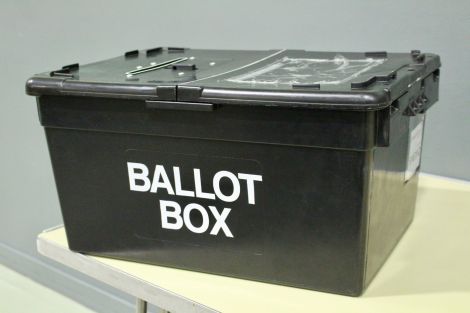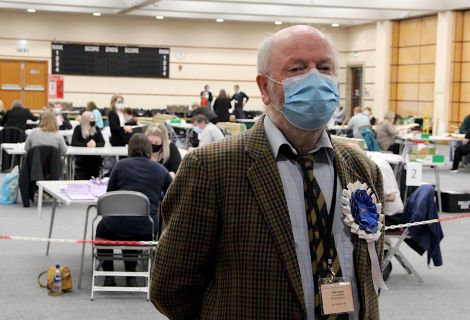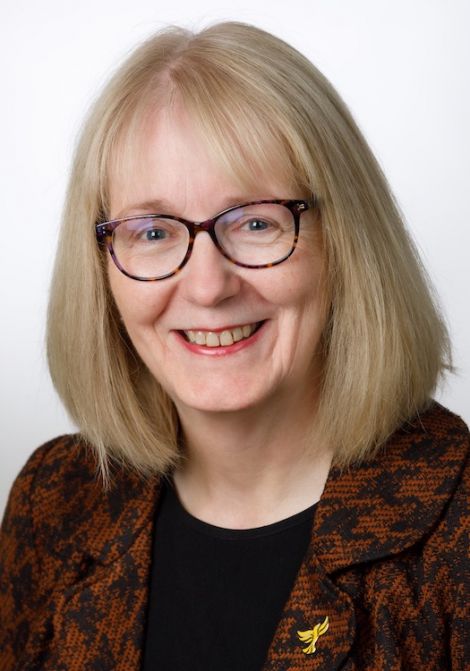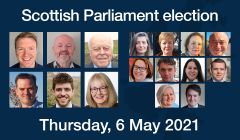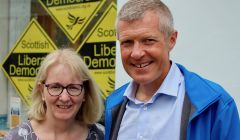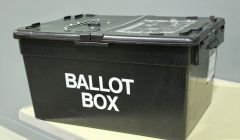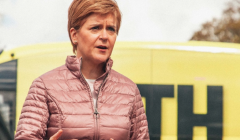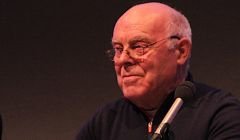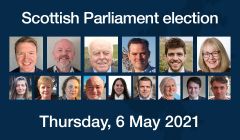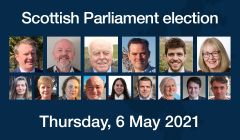Election / Wishart re-elected as Lib Dems hold Shetland seat
The MSP said it is an “honour and a privilege” to be re-elected
Saturday, 8 May, 11.15
As counting continues across Scotland for a second day, Shetland will have to wait until later today (Saturday) to find out who the seven list MSPs for the Highlands and Islands region will be.
On Friday Liberal Democrat Beatrice Wishart held the Shetland constituency seat with a reduced majority. Here is a summary of the figures and some analysis:
- Beatrice Wishart has been re-elected as the MSP for Shetland with 48.6 per cent of the vote, a slight increase from her by-election victory in August 2019, when she received 47.8 per cent;
- She received 5,803 votes, again a slight increase on the 2019 result when 5,659 islanders voted for her in the by-election prompted by the resignation of Tavish Scott;
- However, her majority over Tom Wills from the SNP was more than halved from 1,857 to 806;
- Wills meanwhile, receiving 4,997 votes or 41.9 per cent, returned the SNP’s best ever result in Shetland;
- The Nationalists also managed for the first time in the history of Scottish Parliament elections to win more votes on the list (the second vote on the peach coloured ballot paper) than the Liberal Democrats: 34.5 per cent against 26.5 per cent;
- The SNP can further claim to have doubled their votes in Shetland every five years. In the 2011 Holyrood election Jean Urquhart won 1,134 votes, a result the late Danus Skene managed to double to 2,545 in 2016. This has again doubled in the 2021 election;
- This election has always been described as a two horse race between a Union supporting candidate and one who is challenging the constitutional status quo. Analysing the constituency and list results it can clearly be seen to what extent tactical voting had been taking place, and to what extent Beatrice Wishart benefited from the unionist vote.
While 15.6 per cent of the local electorate gave their vote to the Conservatives on the regional list, in the constituency vote the party’s candidate Nick Tulloch received just over four per cent of the vote - Adding up the pro-union votes and the pro-independence votes from the Shetland list results it appears as though the gap between the two sides has shrunk considerably, with pro-union parties receiving about 51 per cent of the vote.
Become a member of Shetland News
To read Friday’s live feed, please see below:
And this now takes us to the end of our live blog from the Scottish Parliament election count at the Clickimin Leisure Complex.
We will bring you the results for the Highlands and Islands list MSP once they have been announced in Inverness, plus further analysis over the weekend.
The next election will likely be the council election in May 2022, followed by the UK general election two years later, in May 2024.
There is of course the possibility of an independence referendum towards the end of 2023, but that depends on many variables including the final outcome of these elections.
The European Parliament elections, meanwhile, are scheduled for 2024, and they will be the first without the UK taking part.
Speaking after the results Restore Scotland’s Brian Nugent, who came last in the constituency vote, said he would “invite voters to investigate the European Union – undemocratic, bureaucratic and a danger to fishing, and that is list of its better points”.
He thanked those who voted for him, and also thanked the EU for “supplying Restore Scotland with so much ammunition to comment on”.
Accepting defeat, SNP’s Tom Wills noted that result was the best ever for his party in Shetland.
Wills, who works as a marine engineer on a tidal energy project in the isles, added that he felt hampered by the restrictions imposed on canvassing by the pandemic.
“I am disappointed, but the result is also a huge achievement,” he told Shetland News.
“I don’t think I could have given it much more under the circumstances.
“We only had the last ten days of actually getting out, knock on doors and speak to folk; I would have preferred that.
“It has been a strange campaign. It is only then that you get a proper view of what people are thinking and it became clear that we had a lot of support, was supporting us for the first time, but it wasn’t quite enough.”
One takeaway message from the election results is that the Liberal Democrat majority has been significantly reduced from the 2019 by-election.
Back then the gap between the Lib Dems and the SNP was around 1,800, and this time around it is roughly 800.
In 2019 Tom Wills secured 3,822 votes for the SNP, and in this election he bagged 4,997.
Labour vastly improved their performance, gaining 424 votes compared to 152 in 2019, while the Conservatives also secured more votes.
A surprise, however, is that anti same-sex marriage candidate Peter Tait received 116 votes – beating Restore Scotland’s Brian Nugent (90 votes). The latter did not take to the podium for the results despite being in attendance earlier.
Speaking on the podium after the result was announced, Wishart said:
“It’s an honour and a privilege to be re-elected as the Liberal Democrat member of the Scottish Parliament for Shetland. And thank you to the other candidates for their good spirited contest.”
She said there was “unfinished business” following her first term, and added that she was “grateful for the people of Shetland for giving me the opportunity to continue working hard for them on the issues that matter”.
“The pandemic has devastated so many people’s lives, so my message of putting recovery first resonated with voters along with the key themes of action, and improvement on the issues that people told me matters most to them. Mental health services, education, transport and broadband, and there’s so much more.”
Wishart said “I want to focus on making a difference to people’s lives”.
The Shetland results for the Highlands and Islands list vote have also been revealed.
The SNP gained the most votes at 4,108, with the Lib Dems picking up 3,157 votes. The Tories also secured 1,865.
The votes will added to the mix with other constituencies in the Highlands and Islands, and the seven MSPs will be announced via Inverness later.
The votes are as follows:
Beatrice Wishart was won the Shetland seat for a second time in a row.
Shetland is now close to declaring – perhaps within the next 15 to 20 minutes. Indications are that it is quite close between Lib Dems Beatrice Wishart and Tom Wills of the SNP.
Meanwhile SNP candidate Tom Wills and his wife Andrea have also arrived at the count ahead of the declaration. We’re expecting the results soon…
Lib Dem candidate Beatrice Wishart has arrived at the count.
She was elected as MSP at the by-election in 2019 and is looking for success again in today’s count.
The remaining constituency candidate not mentioned here yet is independent Peter Tait, who stood on the controversial stance of opposing same-sex marriage.
He also competed in the 2019 by-election on a monarchy issue, coming last with 31 votes.
It remains to be seen if he will secure less votes this time around, with his beliefs proving unpopular on social media.
Members of the Scottish Parliament are being elected through a combination of the first past the post system and what is called the additional member system. This was introduced by the founders of the parliament to ensure a more proportional representation in the chamber and also to prevent one party from gaining an outright majority.
Scotland’s 73 constituency MSPs are being elected by the first past the post system, while the remaining 56 so-called list MSPs, seven MSPs from eight different regions including the Highlands and Islands, are elected via the additional member system.
During the 2021 Scottish Parliament campaign there was a particular emphasis on the list vote as quite a number of parties, such as the Greens, the newly formed Alba party but also All4Unity and others, decided not to contest the constituency and instead focused on the list to take advantage of some of the weaknesses in the system.
So, how does it work? It is best explained by using the 2016 election result, when the SNP won seven and the Lib Dems bagged two of the nine Highlands and Islands constituency seats.
Generally speaking, the more constituency MSPs a party wins, the less chance it has to gain additional seats via the list.
To start determining the distribution of seats via the list, the number of votes each party has gained is divided by one plus the number of MSPs the party has won in the constituency.
As the table shows, in 2016 the SNP won 81,600 votes in the Highlands and Islands region, so their tally is divided by eight (one plus seven constituency MSPs), whereas the Conservative’s 44,693 votes are divided by just one as they did not win any of the constituency seats.
Following the same logic, the Lib Dems’ votes of 27,223 are divided by three, and Labour’s and the Greens by one.
Accordingly, the Conservatives win the first of the list MSP seats because their number of votes is now the highest.
After that the party’s original number of votes is divided by two (one plus one list MSP). Looking at the figures again, this time Labour at 22,894 comes top and the second list MSP seat goes to this party. The Labour list vote is divided by two and now the Greens win a list MSP seat.
This process is repeated until all seven seats are taken.
For illustration purposes only, let’s assume then MSP Tavish Scott did not win a majority in the constituency contest in 2016, then the Lib Dems’ votes of 27,223 would only have been divided by two rather than three, and Inverness South councillor Caroline Caddick, who was lead candidate on the Lib Dems’ list in 2016, would have been elected as the party’s list MSP. Scott, unlikely to lose his Shetland seat, was not put forward for the list.
The Liberal Democrats have held their seat in Orkney, with Liam McArthur securing more than 7,000 votes there.
The SNP’s Robert Leslie got 3,369, with Conservatives third and Labour fourth.
Orkney is the first constituency in Scotland to declare a result.
The Conservatives and their candidate Nick Tulloch will be hopeful of the bronze medal in the Shetland constituency.
Brydon Goodlad bagged 425 votes in the 2019 by-election, or 3.59 per cent, to come fourth behind independent candidate Ryan Thomson, who is not standing this time.
Speaking at the count, Tulloch said he has had a “very positive campaign”, with the economy, health and education his key issues.
He added that “independence comes up time and time again” in conversations on the campaign trail, with his party firmly against Scotland going it alone.
Tulloch did highlight the unusual nature of the election this time around, due to Covid restrictions – with much of his time spent behind the keyboard.
It is fair to say this election has been rather different than usual.
Door to door canvassing was permitted, but campaigning felt somewhat restrained compared to previous years.
For voters, polling places were decked out with screens and hand sanitiser, while booths were regularly cleaned.
The usual masks and physical distancing rules are in place, and voters were able to take in their own pencils or pens.
Today’s count is a rather different beast, too.
It usually takes place overnight following the vote, fuelled by coffee, sandwiches and a healthy dose of adrenaline, with the results coming in the early hours.
But in light of restrictions around the number of staff, the counting is being carried out across Scotland today.
The usual buzz of the count – where guests, candidates, party representatives and the media all mingle – is more subdued this time around, with no guests allowed and numbers restricted.
The latest murmurs on the floor suggest that we could be expecting the results of the Shetland constituency at around 3pm – but with plenty of variables at play, things could easily change.
Shetland’s two members of the Scottish Youth Parliament Jonathan Dorrat and Leighton Anderson can’t be in attendance at the count due to Covid restrictions.
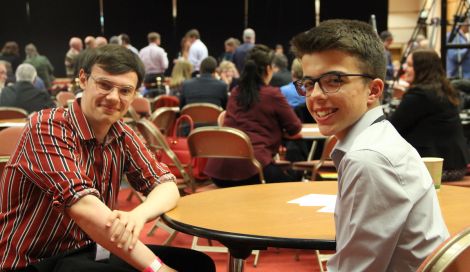
But they told us that “Shetland’s new MSP should reach out to young people in their settings, by visiting schools and youth clubs for example. Equally a strong presence on social media will also help reach out to younger constituents in our Isles.”
The below is from Dorrat as he gives his hopes for the next Scottish Parliament term:
“This election has been the first time many young Shetlanders have had the opportunity to cast their vote and have their voice heard. For 16 and 17 year old voters this right was successfully campaigned for in 2014 by the Scottish Youth Parliament appearing in their 2011 manifesto.
“The Scottish Youth Parliament (SYP) have recently launched their new five year manifesto From Scotland’s Young People which is to inform Political Parties of what changes Young Scots want to see in the next parliamentary term.
“Locally Leighton and I carried out extensive consultation on the issues covered in the manifesto and know that it is an accurate representation of what local young folk want to see changed within a new Scottish Parliamentary term. As MSYPs we look forward to working with whoever is elected as Shetland’s MSP and hope to tackle some of these issues.
“Key points from the manifesto which directly relate to the lives of local young people include:
“Connectivity
“Having a reliable Internet connection was the difference between accessing education or falling behind for students over the last year. Shetland has many areas with poor and very poor internet connectivity and this has caused further inequalities during the pandemic. As the community recovers Young People need the reassurance that if they are expected to learn online in the future that they will have a reliable internet connection or mobile data solution to access their right to education.”
“Mental Health
“It has been said that we are facing two pandemics, Covid-19 and a mental health one which has been around a long time. Young people face huge waiting lists to receive mental health support in Shetland and this is unacceptable. The introduction of school counsellors was welcomed however there is still ground to be covered to improve support for mental health locally.”
Sports & Leisure
“Shetland has fantastic sports and leisure facilities and programmes specifically for young people. Getting out and being active helps mental health and wellbeing. Therefore it is paramount that these services continue to receive funding in the recovery from the pandemic.”
Transport
“As an island community transport affects the daily lives of everyone, however it can be less accessible to young people due to cost both locally and to the mainland as well as barriers created due to geographical location. Previous consultation we’ve conducted as Shetland MSYPs locally showed transport was the biggest issue facing young Shetlanders.”
“Further to the major issues in the manifesto, young people in Shetland want to see the MSP as someone who they can easily approach and work with. In our role as MSYPs we can support our constituents to get in touch with elected representatives including MSPs so a positive working relationship with young people and Youth Representatives is key.”
The polling place with the highest turnout in the Shetland vote was Uyeasound Public Hall in Unst, where 73.7 per cent of electors voted.
Other places with high figures included Quarff (72.5 per cent), Lunnasting (69.6 per cent) and Bressay (69.3 per cent).
The lowest turnout was station three at the Clickimin, which had a figure of 48.5 per cent.
The total number of voters was 11,968, which is up by 144 on the 2019 by-election.
More than 4,000 people voted by post, with the postal turnout coming in at 87.22 per cent.
The overall turnout in the Shetland constituency vote was 66 per cent, it has been confirmed. This is about the same as the 2019 by-election.
In the Highlands and Islands regional vote that figure is 65.82 per cent.
A party aiming for an improved performance in Shetland is Labour, who are represented by Martin Kerr.
The 2019 by-election saw Johan Adamson pick up only 152 votes, and it remains to seen how they will fare this time around.
Kerr said he has the right experience, as a lawyer and a campaigner, to stand up for the Shetland community.
His campaign focused on the recovery from the Covid pandemic, while he said he strongly opposed the centralisation of air traffic control and supported fixed links for Shetland.
The first constituency candidate at the count was Restore Scotland’s Brian Nugent.
His party wants Scotland to be independent, but out of the EU too, and that attracted much of his focus during the campaign.
Although he is standing in the Shetland constituency, Nugent also is the lead candidate for Restore Scotland in the Highlands and Islands list vote.
Speaking at the count, he reflected: “We are a relatively new party so to an extent we have been learning as we go along.”
After watching the counting unfold, Nugent conceded he had failed in his wish to beat Labour and/or the Conservatives.
He said a debrief will be held to “work out what worked, and what didn’t work”.
The SNP are again represented by Tom Wills, who stood in the 2019 by-election where he came second.
Wills, who works in tidal energy, said he wants to “help Shetland reach its full potential”.
Speaking to Shetland News this week, first minister Nicola Sturgeon praised him as an “advocate” for the community and said he was already speaking up for the isles in talks with her.
The margin in the 2019 by-election between the SNP and the Liberal Democrats was around 1,800 votes, and it remains to see how this gap will look this time around.
The favourite in the election is Liberal Democrat candidate Beatrice Wishart, who is looking to be re-elected after becoming Shetland’s MSP in 2019.
Prior to landing a seat in Holyrood she had been a councillor for the Lerwick North ward, and before that she worked in Alistair Carmichael’s office.
Speaking to Shetland News earlier this week, Scottish Lib Dem leader Willie Rennie praised Wishart for her determination to get on with the job and highlighted her work supporting constituents.
A key focus of her campaign was pushing the emphasis on the recovery from Covid, while local topics on her agenda included mental health, fixed links and plans to centralise air traffic control.
The number of people registered vote in Shetland for this election was the highest on record.
The electorate this time around is 18,134, although the number of people actually turning out to vote tends to be 60-odd per cent.
By 5pm yesterday the overall turnout was 44 per cent.
This year a total of 4,679 people have chosen postal votes, which is a marked increase on previous years.
This is mainly due to the impact of the coronavirus pandemic, with people encouraged to vote by post if they did not want to do it in person. Shetland’s outer isles are already mainly postal voters.
There were 34 polling stations open across Shetland yesterday, between 7am and 10pm.
The largest was the Clickimin Centre, which was used because the Gilbertson Park games hall was hosting Covid vaccinations.
Become a member of Shetland News
Shetland News is asking its many readers to consider paying for membership to get additional features and services: -
- Remove non-local ads;
- Bookmark posts to read later;
- Exclusive curated weekly newsletter;
- Hide membership messages;
- Comments open for discussion.
If you appreciate what we do and feel strongly about impartial local journalism, then please become a member of Shetland News by either making a single payment, or setting up a monthly, quarterly or yearly subscription.


































